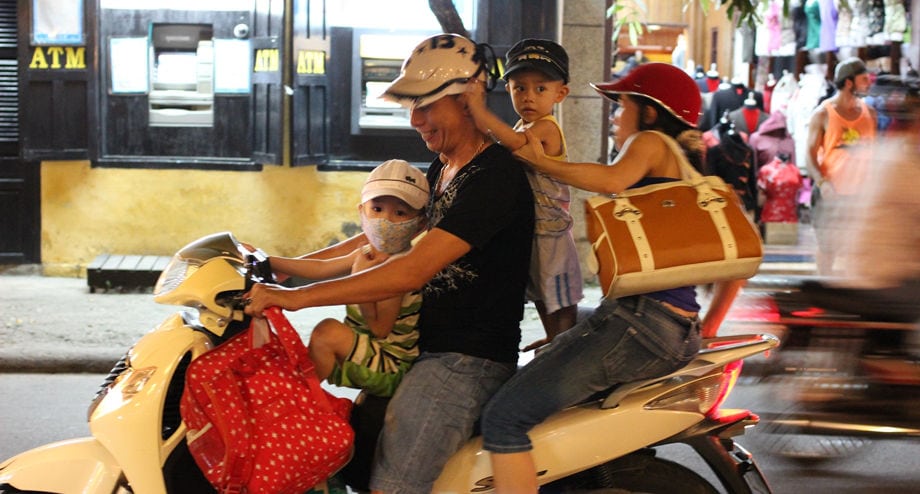
Before arriving in Vietnam I was expecting a country similar to southwest China with less pollution and more scooters. And I was right!
No, wait, I’m just joking. There are a lot of differences between China and Vietnam.
In this post I would like to underline ten habits of Vietnamese that surprised me (keep in mind this is the first time I visited South East Asia).
But lets the images talk!
Who says you need a car to grow a family?
In Vietnam, few people have a car and public transportation is quite poor. Hence people learned how to optimize the space on their scooter (see the above image).
Do you really need to rent a room to start a business?

Walking around the old neighborhoods of Hanoi it’s not difficult to stumble upon any sort of street business. This man, for instance, opened a barbershop on the sidewalk. Despite this fact, he seems to care about his customers’ privacy. Contradictory.
Equilibrists
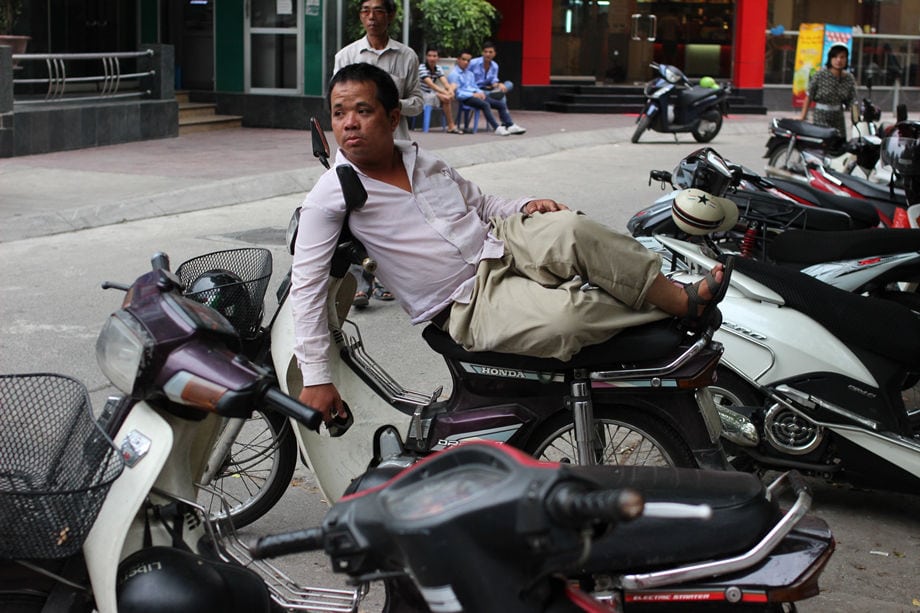
Vietnamese are able to perform any sort of action by keeping the equilibrium on their scooter. Reading a newspaper, eating noodles, sleeping, or just watching the tourists (as the guy in the photo above) are just some of the most common on-the-scooter activities. Amazing
How to transport anything in a scooter
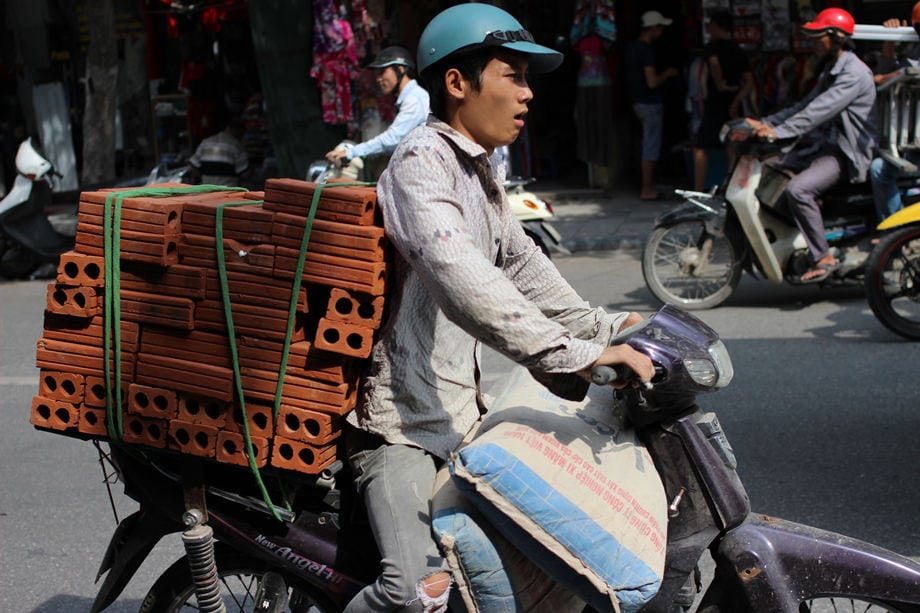
Not only they can fit their whole family in a scooter, but Vietnamese also have the ability to transport virtually anything on it. The only problem of this funambulistic performance is that to keep the goods in equilibrium they cannot stop. In fact, they cannot even slow down…
The ultimate squatting
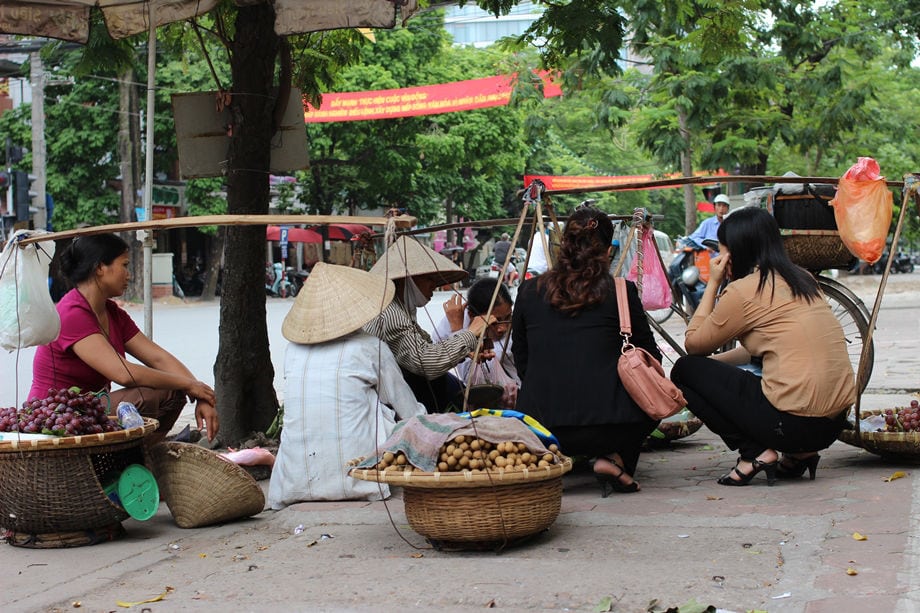
If you have traveled around Asia, you will already know how much Asian people love the squat position (not only at the toilet!). However, I found Vietnamese taking the “squat affair” much more seriously than Chinese people. In the above photo, for instance, customers and vendors carried out the entire bargaining-buying process of fruit in the squat position!
Scooters are dangerous
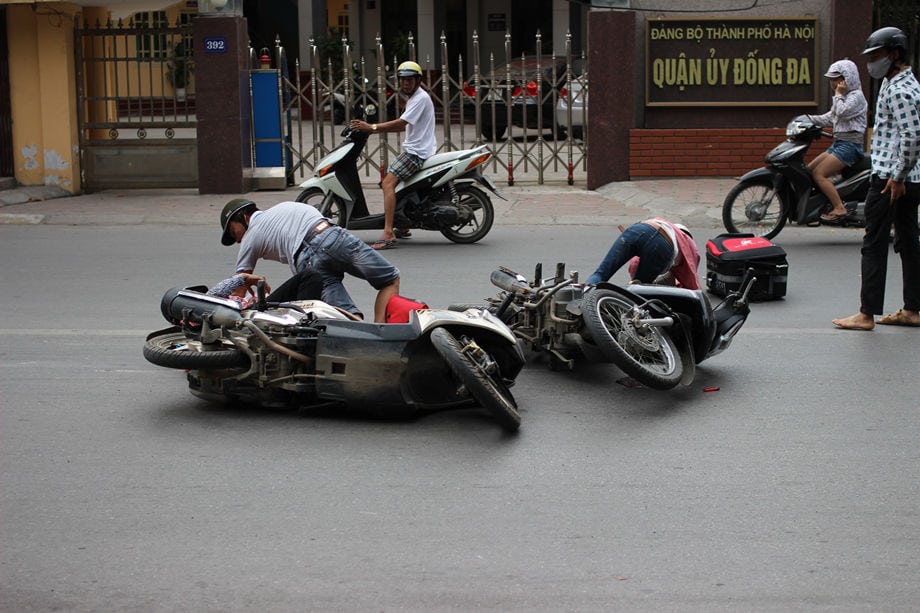
Especially in Hanoi and Saigon, it’s quite common to assist in a motorbike accident. This is normal if you consider that Vietnamese drivers never stop. Sometimes they cannot even consider the possibility of stopping because by losing inertia the heavy goods they are transporting will collapse and drag the scooter on the tarmac with them.
Instead of slowing down, Vietnamese prefer to avoid obstacles by keeping the same speed or, when they estimate it can help, accelerating. The only problem is that this strategy often fails to provoke an accident as in the photo.
C’est la France!
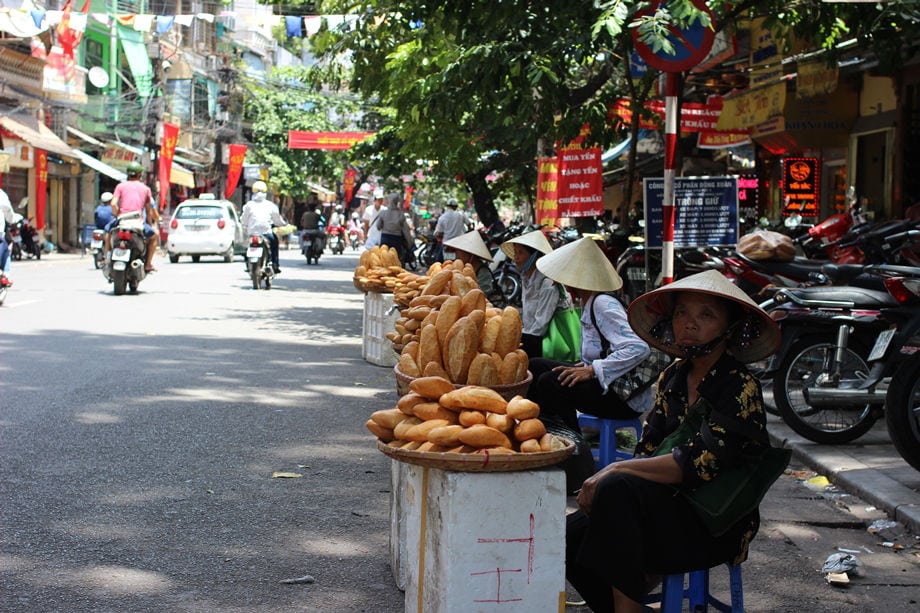
French people didn’t leave much wealth when they were kicked out of Vietnam. However, they left the tradition of coffee and baguettes! Hilarious.
What to do if you don’t have a scooter?
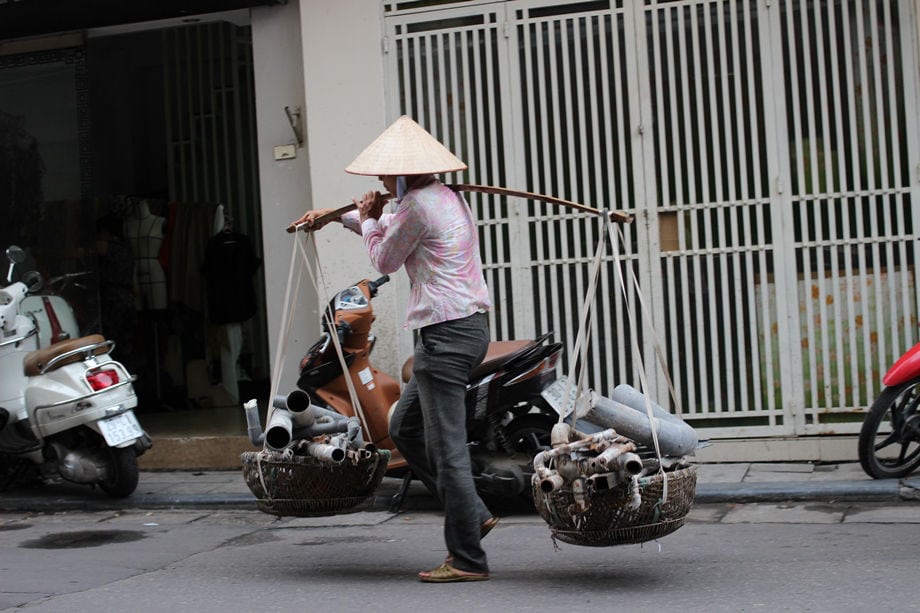
In Vietnam the most common way of transportation (after a scooter) is a balance kept in equilibrium in a shoulder. I did see Chinese people using a similar tool (especially in Guangxi province). However, I had never seen a girl walking around with pipelines or other building materials on it.
Wanna buy my socks?
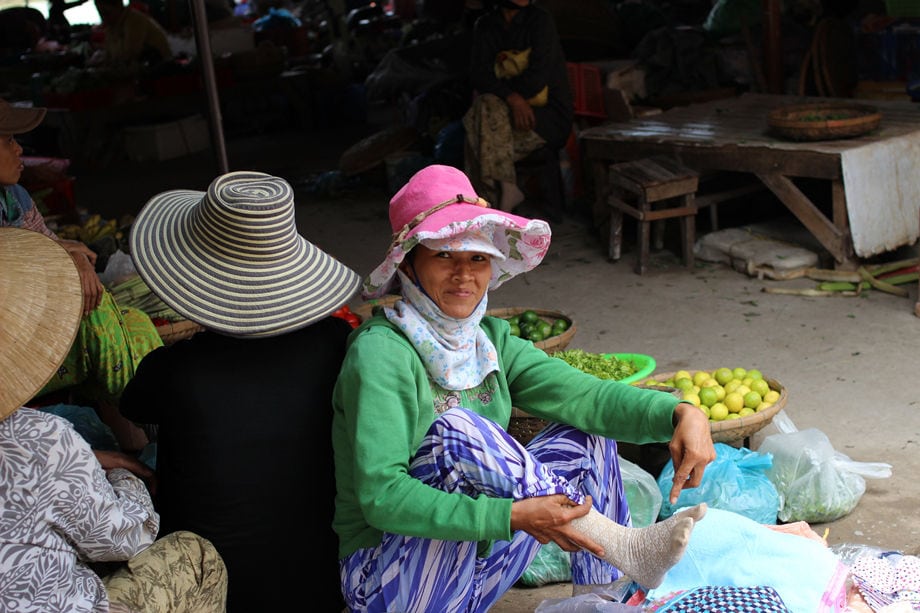
In Vietnam, virtually everybody will try to sell you something. I know this happens (as for the unconventional ways to transport building materials and so on) because it’s a very poor country.
So I try my best to avoid getting annoyed even if every guy on the street is trying to sell me fruit/photocopied-novels(?!)/fake-D&G-sunglasses/a-ride-on-his-scooter/whatever.
I must say Vietnamese vendors are full of inventive (especially in the most touristic spots as Halong Bay, Hoi An, or Nha Trang). For instance, the girl in the photo above was trying to sell me socks at the fish market. Her selling strategy was to point her dirty socks. Masochist.
I don’t get this one
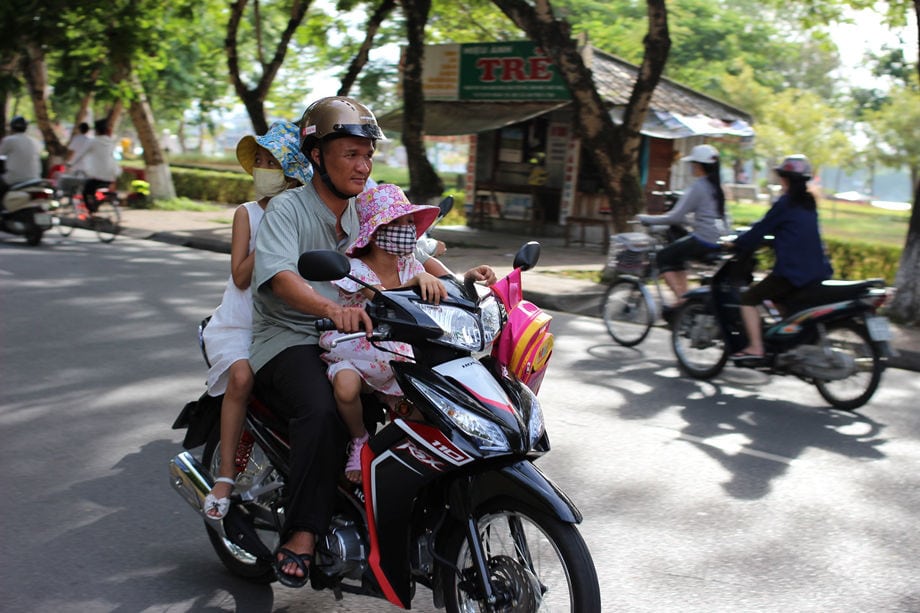
In Vietnam, it’s common to see an adult in a scooter with his kid. The problem is that often the adult is wearing a helmet while the kid is not. Weird.
Photo Credits: Photos by Sapore di Cina

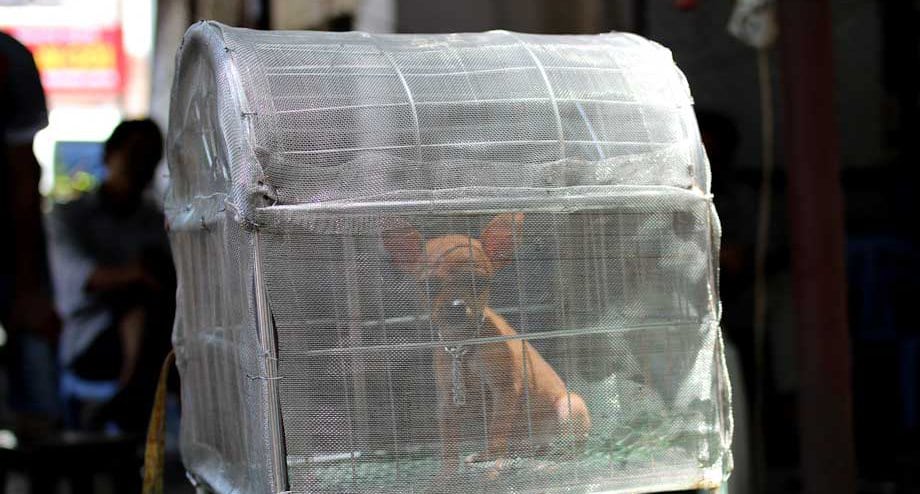


I honestly couldn’t imagine Vietnam without scooters. It’s the first thing that comes to mind when I think of my travels there :)
Yup,
scooters, shrimps and spring rolls ; )
when I came for the first time in1988 by package-tour (we were not allowed to go there alone) there were no motorbike, just bicycle, a lot of bicycle. It was so marvelous ! Thailand is so much better than Viet Nam now.
Thank you for the comment Dan!
Motorcycle culture there is insane, right? I did a post on it too because of all the Southeast Asian countries I’ve seen, Vietnam was the craziest w/ the bike. They did everything on it- they could practically build a house on it and the balancing act they do transporting things is not only dangerous but they really pack a mountain on their bikes.
You got some fun shots of the scooter spill and the hawker carrying all those lead? pipes? Vietnam wasn’t my favorite country but it did have several very unique aspects to it that give me fond memories.
Hey Christine, thank you for the comment and the retweet : )
A couple of days after I published this post I went to the Mekong Delta (only a couple of hours for lack of time, I’m so jealous you to got to see the floating markets : p ) and our guide explained WHY there are so many motorbikes in Vietnam.
Basically it comes down to the fact that they have no infrastructure for cars (streets, parkings, …). Then the government put a crazy tax on cars (I have no the exact numbers but the tour guide was talking about 200/250%) so that ordinary people cannot afford them.
Hence motorbikes became the only way to go.
Anyway, the last day I shot some videos in a very busy crossroad of Saigon so I’m going to publish soon a post entirely devoted to the Vietnam motor bees ; )
p.s when you have time tell me the URL of your post about Vietnam bikes, I’m curios to check it
I think that it would be worst if you changed every motorbike by a car, motorbike need less space.
Incidentally, I showed your pictures to half a dozen Chinese friends today and asked them to guess where they were taken. They answered “China” to every one except the baguettes.
Just like I said.
I feel I already answered to your concerns on my first reply, so I quote myself:
“South West China and Vietnam were two completely different experiences for me, and this was the main message of this post.”
Then of course, if you take an isolate picture and show it to someone it may looks as South West China, Thailand, Vietnam or Laos…
Does it means all these countries are the same?
Take photos 6, the one of the accident. Of course accidents can happen everywhere in Asia, but in Vietnam the motorbikes are too crazy. They look like a flock of bees…
I never feel in danger while I’m walking in China, but crossing the street in Hanoi was quite an experience (especially the first days) and I even had a girl running over me with her scooter (although she was not running too fast so I didn’t get injured).
Also, you see injured laowai all over the place (most of them victims of the traffic).
Again, traveling to China and Vietnam are two very different experiences and this was the main message of this post.
And so far any person I met that had traveled around both countries agree with me
Thank your for the comments (even if we have a different opinion I value your ideas as you have lived in China for many years) and for showing my blog to your friends : )
You said “town”.
Wow guys, to me it’s all new… And amazing!!!! I think that you’re having a really good time, so… Continue enjoying!!! And take care of my beloved Elena, so many scooters for her ability to have accidents… xx
Hey Ali,
thank you for the comment!
And don’t worry, Elena is really good at avoiding the motorbikes
Un abrazo!
I just can’t stop laughing with the pic of the woman showing her socks… xDD
The moment was so hilarious!!!!!
Ali, after 3 weeks of crossing streets in Vietnam, I became a master at avoiding motorbikes!!! Actually, crossing the street is more an “act of faith”!!! Hehehehehe!!!! You just have to do it without thinking, hoping not to get runned over!!! xDD
Liuzhou is actually Guangxi’s second largest city (after Nanning).
Hey,
thank you for your answer!
I quote from an article I read a couple of months ago following a link at Chenguduliving.com:
“Cities in China are typically classified according to location, population, and general economic statistics. Beijing, Shanghai, Guangzhou, Shenzhen, Tianjin and Chongqing are generally classified as Tier 1 cities, while provincial capitals are generally classified as Tier 2. Important cities, like Mianyang, are classified as Tier 3, and many analysts carry the classifications further and use Tier 4 to denote cities that are large and important by any standard, but are even less well known.”
(source:
So answering to your comment I assumed that Nanning is a second tier city while Liuzhou is a third tier city.
Greetings from Da Lat
Apart from the baguettes, I can’ t see any difference between this and SW China.
Hey,
thank you for your comment. I’ve always lived in East China, where things are a bit different. I do agree South West China is similar to Vietnam (especially Guanxi and South Yunnan) and this is why I open the article with this parallel.
However there are huge differences, especially on the numbers.
For instance, while in China you can occasionally spot four people on the same scooter or someone transporting building material in a balance, the habits I underlined in this article are the normality in Vietnam (that is you will see them every two minutes).
Also, I’ve been to Guilin and Yangshuo (arguably the most touristic spots in South West China) and, even if there was the occasionally local pitching me a tour or a pair of sunglasses, it was more an isolated event than a constant line of persistent people shouting at me:
“Buy something from me,”
“What are you looking for?”
“Hey my friend, where do you come from?”
Yunnan was a much more quiet and experience.
So South West China and Vietnam were two completely different experiences for me, and this was the main message of this post.
Then again you live in a third tier (I guess so, at least) town of Guanxi so I understand you see South West from a totally different perspective than me, that is a simple traveler ; )